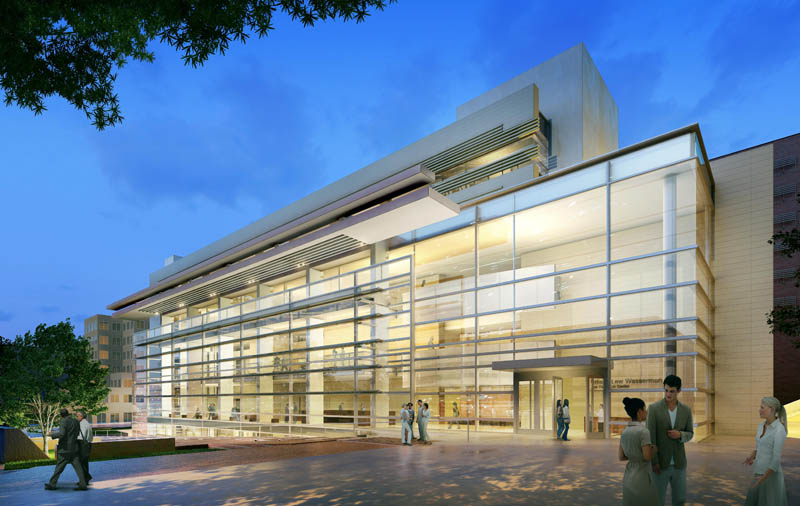A state-of-the-art research center slated to open in 2014 in Stein Plaza will boast 3-D surgical imaging technology, new programs to treat eye diseases and a patient-centered approach to care that experts say is the first of its kind in the U.S.
“This building is ground zero for the future of medicine,” said Neil Martin, professor and chair of neurosurgery at UCLA.
The $115.6 million Edie and Lew Wasserman Building, zoned for the north side of Stein Plaza, will house the Jules Stein Eye Institute in addition to two departments in the David Geffen School of Medicine.
Stein Plaza already includes the Jules Stein Eye Institute and the Doris Stein Eye Research Center. The addition of the Edie and Lew Wasserman Eye Research Center in the building symbolizes the culmination of a relationship that formed nearly 80 years ago.
The six-story, 100,000-square-foot structure is a product of Richard Meier & Partners Architects, the same architecture firm that designed the Getty Center.
The project will not require state funds. The Jules Stein Eye Institute, the Wasserman family and the David Geffen School of Medicine will split the costs of construction.
While the initial planning for the research center began in 1998, the center has its origins in the 1920s, when Jules Stein and Lew Wasserman formed a close business relationship in the music recording industry.
When the Wasserman Foundation was established in 1952, it became a key funding source for the Jules Stein Eye Institute, which Stein founded at UCLA in 1966.
In 1989, the institute expanded with the construction of the Doris Stein Eye Research Center. With additional funds available, the institute began seeking more ways to increase its capacity in the late 1990s.
A limited number of new researchers have been able to enter the institute, and current researchers have been constrained by the lack of lab space.
“We’re crowded now,” said Bartly Mondino, director of the Jules Stein Eye Institute. “We’ve had no room to grow.”
The push for expansion found a crucial ally in Casey Wasserman, the grandson of Lew Wasserman and current president of the Wasserman Foundation. Casey Wasserman was a driving force in the planning and execution process, Mondino said.
After a series of delays, construction will begin in November. To make room, a “seismically deficient” portion of the Semel Institute building will be demolished, according to UCLA spokesman Phil Hampton.
The new space in the Wasserman building will enable the institute to expand its existing facility and create new ways to treat eye diseases, particularly in stem cell technology, Mondino said.
The new building will also host the neurological sciences department on its top two floors. Currently spread across eight different buildings, the department’s consolidation is expected to allow it to increase the number of patients served by 50 percent and double the research capacity of doctoral students and post-doctoral students, Martin said.
High-tech features will give the top floor of the building a futuristic feel. An IMAX-format conference room will allow surgeons to virtually review brain and spinal anatomy and complete surgical procedures, and a broadband connection will allow a surgeon in Germany to “beam in” and give lectures as a life-sized display, according to Martin.
Patient care and education will combine in the form of DVDs and Internet content. In modern medicine, an educated partnership between the physician and the patient is key, Martin said.
That theme of partnership runs throughout the research center. The two-year-old Institute of Urologic Oncology plans to use its space as a platform for a form of patient care that director Arie Belldegrun terms “revolutionary.”
Instead of the patient traversing a system of specialists and departments for a second opinion after a diagnosis, the specialists and departments will all be under the same roof, a patient-centered program that Belldegrun said is found nowhere else in the U.S.
Belldegrun added that, while the idea sounds simple, the process of combining departments and disciplines ““ in this case, the urologic oncology, kidney, testicular and prostate programs ““ into a single facility requires more collaboration and concessions than meets the eye.
“You will find that many institutes in the world could not get together all these experts in one room, decide they would like to work together, and decide they need a new way of collaborating,” Belldegrun said.
The consolidation means that individual departments will lose a certain level of autonomy. But Belldegrun said UCLA is uniformly committed to what is best for the patient.
He said he cannot predict the effect on the cost of care, but that the approach will significantly reduce the time a patient spends in clinical care. With the current level of separation between departments, the time between diagnosis and treatment often amounts to weeks or months.
For example, a patient diagnosed with prostate or kidney cancer must go to a different facility for a second opinion from another expert, and doctors don’t always communicate.
There, the UCLA program will differ, Belldegrun said.
“Each disease will have all the experts in one area, which means that if a patient comes, he can see (and) discuss with all the physicians at the same time,” Belldegrun said. “It’s a coordinated effort.”
